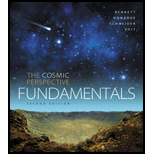
Explain all answers clearly, with complete sentences and proper essay structure if needed. An asterisk (*) designates a quantitative problem, for which you should show all your work.
Observing Project: Jupiter’s Moons. Using binoculars or a small telescope, view the moons of Jupiter. Make a sketch of what you see, or take a photograph. Repeat your observations several times (nightly, if possible) over a period of a couple of weeks. Can you determine which moon is which? Can you measure the moons’ orbital periods? Can you determine their approximate distances from Jupiter? Explain.
Want to see the full answer?
Check out a sample textbook solution
Chapter 6 Solutions
The Cosmic Perspective Fundamentals (2nd Edition)
Additional Science Textbook Solutions
Physics: Principles with Applications
Physics (5th Edition)
Physics for Scientists and Engineers: A Strategic Approach, Vol. 1 (Chs 1-21) (4th Edition)
Modern Physics
College Physics
Physics for Scientists and Engineers with Modern Physics
- Answer the question below showing detailly each step of your working. Solution should be clear, simple and explicit enough and must be typed with the use of a computer keyboard only!arrow_forwardformat in solving: 1. given 2. diagram (simple labeled sketch) 3. solution (use formula from formula sheet) 4. therefore statement (full answer with correct sig figs)arrow_forwardPlease include a complete answer. Do not skip any steps. Please double check your work and include notes where appropriate.arrow_forward
- Choose the best answer to each of the following. Explain your reasoning. Which of the following is not true during Northern Hemisphere summer? (a) Sunlight strikes the ground at a steeper angle in the Northern Hemisphere that it does in the Southern Hemisphere. (b) The Sun follows a longer and higher path through the Northern Hemisphere sky than it does through the Southern Hemisphere sky. (c) Noontime shadows are longer in the Northern Hemisphere that in the Southern Hemisphere.arrow_forwardA balloon, in the shape of a right circular cylinder, is being inflated in such a way that the radius and height are both increasing at the rate of 3 cm/s and 8 cm/s, respectively. What is the rate of change of its total surface area when its radius and height are 60 cm and 140 cm, respectively?arrow_forwardShow your complete solution and illustrate if applicable. box the final answer. Please write your solution clearly and readable. Thank you.arrow_forward
- Use a sketch, an equation in addition to your precise and concise description. Please give a very detailed answer. 1) Discuss the process of spontaneous parametric down-conversion.arrow_forwardWrite the detailed solution (Given, Unknown, Formula, Step-by-Step Solution). Box your final answer. Please make sure that your handwritten is readable. Thank you.arrow_forwardQuestion Completion QUESTION 11 Consider two vectors and shown in the figure below. A The vector subtraction- A-B is best illustrated by OA. O B. Save and Submit to save and submit. Click Save All Answers to save all answers.arrow_forward
 College PhysicsPhysicsISBN:9781305952300Author:Raymond A. Serway, Chris VuillePublisher:Cengage Learning
College PhysicsPhysicsISBN:9781305952300Author:Raymond A. Serway, Chris VuillePublisher:Cengage Learning University Physics (14th Edition)PhysicsISBN:9780133969290Author:Hugh D. Young, Roger A. FreedmanPublisher:PEARSON
University Physics (14th Edition)PhysicsISBN:9780133969290Author:Hugh D. Young, Roger A. FreedmanPublisher:PEARSON Introduction To Quantum MechanicsPhysicsISBN:9781107189638Author:Griffiths, David J., Schroeter, Darrell F.Publisher:Cambridge University Press
Introduction To Quantum MechanicsPhysicsISBN:9781107189638Author:Griffiths, David J., Schroeter, Darrell F.Publisher:Cambridge University Press Physics for Scientists and EngineersPhysicsISBN:9781337553278Author:Raymond A. Serway, John W. JewettPublisher:Cengage Learning
Physics for Scientists and EngineersPhysicsISBN:9781337553278Author:Raymond A. Serway, John W. JewettPublisher:Cengage Learning Lecture- Tutorials for Introductory AstronomyPhysicsISBN:9780321820464Author:Edward E. Prather, Tim P. Slater, Jeff P. Adams, Gina BrissendenPublisher:Addison-Wesley
Lecture- Tutorials for Introductory AstronomyPhysicsISBN:9780321820464Author:Edward E. Prather, Tim P. Slater, Jeff P. Adams, Gina BrissendenPublisher:Addison-Wesley College Physics: A Strategic Approach (4th Editio...PhysicsISBN:9780134609034Author:Randall D. Knight (Professor Emeritus), Brian Jones, Stuart FieldPublisher:PEARSON
College Physics: A Strategic Approach (4th Editio...PhysicsISBN:9780134609034Author:Randall D. Knight (Professor Emeritus), Brian Jones, Stuart FieldPublisher:PEARSON





